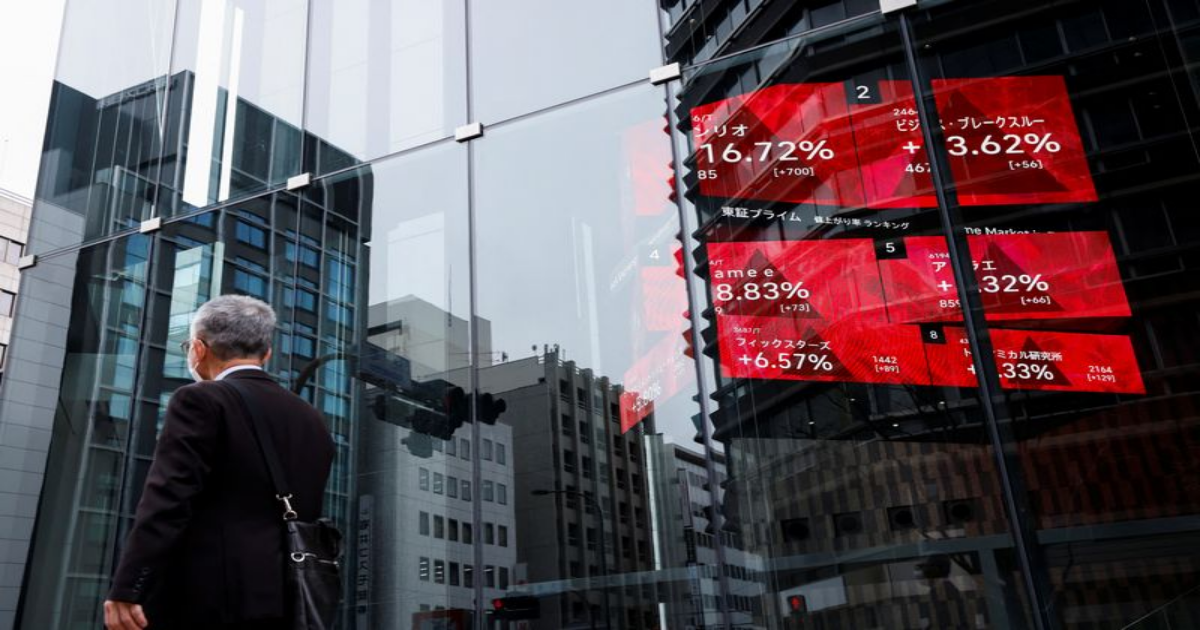By Rae Wee
SINGAPORE (Reuters) -Asian stocks rose slightly on Thursday, riding on optimism from Nvidia’s brief rise to a world-record $4 trillion valuation and as investors largely shrugged off U.S. President Donald Trump’s latest tariff salvos.
U.S. copper futures widened their premium to the London benchmark overnight after Trump announced plans to impose a 50% tariff on copper. He later said on Wednesday the levies would come into effect on August 1.
Trump also turned his trade ire against Brazil on Wednesday as he threatened a punitive 50% tariff on exports to the U.S. and issued tariff notices to seven minor trading partners.
The latest moves did little to rattle markets, leaving MSCI’s broadest index of Asia-Pacific shares outside Japan up 0.2%.
The Nikkei fell 0.56%, while China’s CSI300 blue-chip index rose 0.2% and Hong Kong’s Hang Seng Index added 0.1%.
EUROSTOXX 50 futures gained 0.18% and FTSE futures advanced 0.33%.
Artificial intelligence chip designer Nvidia on Wednesday became the world’s first company to hit a $4 trillion market value, as it solidified its position as one of Wall Street’s most favoured stocks.
U.S. stock futures eased slightly in Asia on Thursday, with Nasdaq futures and S&P 500 futures both down about 0.2% each, after both indexes closed higher in the cash session overnight.
The market reaction to Trump’s tariff developments this week has been much less severe than the post “Liberation Day” selloff in April, with Jeff Ng, SMBC’s head of Asia macro strategy, saying investors have grown somewhat “numb” to the ever-changing situation.
“They know that there is still room for negotiation. A lot of these announcements, they start off with eye-catching numbers, but they are not totally final, and they are still subject to changes. Even if they are implemented, they could also be reversed in the coming few months to year,” he said.
Also keeping stocks supported were expectations of Federal Reserve rate cuts later this year.
Minutes released on Wednesday showed “most participants” at the Fed’s meeting last month anticipated rate cuts would be appropriate later this year, with any price shock from tariffs expected to be “temporary or modest”.
“Right now, markets are not pricing in a high chance of a full-blown recession at this stage, given that the labour market continues to be quite resilient, but they know that there’s a lot of pressure to push policy rates lower, so that could lower the opportunity cost of holding equities,” Ng said.
DOLLAR EASES
The dollar was on the back foot on Thursday, falling 0.4% against the yen to 145.79 after a sharp rise earlier this week when Trump slapped Japan with 25% tariffs.
The euro was up 0.17% to $1.1742 and sterling gained 0.11% to $1.3605.
An exception was the Brazilian real, which languished near a one-month low at 5.5826 per dollar owing to Trump’s tariff threat on Latin America’s largest economy.
“Despite the S&P 500’s impressive rally, the U.S. dollar continues to retreat, underscoring a shifting global macro narrative,” said Julia Wang, global market strategist at J.P. Morgan Private Bank.
“We believe the greenback remains 5-15% overvalued and expect continued weakness as cyclical convergence and capital reallocation trends play out.”
In cryptocurrencies, bitcoin hovered near a record high and was last at $111,234.63, while ether was up 1.3% to $2,775.54.
“We’re seeing our clients take a more measured approach, making strategic allocations into cryptocurrencies with real utility instead of chasing short-term moves. Bitcoin remains the top pick on our platform,” said Gracie Lin, OKX’s Singapore CEO.
Elsewhere, oil prices fell on Thursday, with Brent crude futures down 0.16% to $70.08 per barrel, while U.S. crude lost 0.22% to $68.23 a barrel. [O/R]
Spot gold rose 0.3% to $3,322.69 an ounce. [GOL/]
(Reporting by Rae Wee; Editing by Jamie Freed)
